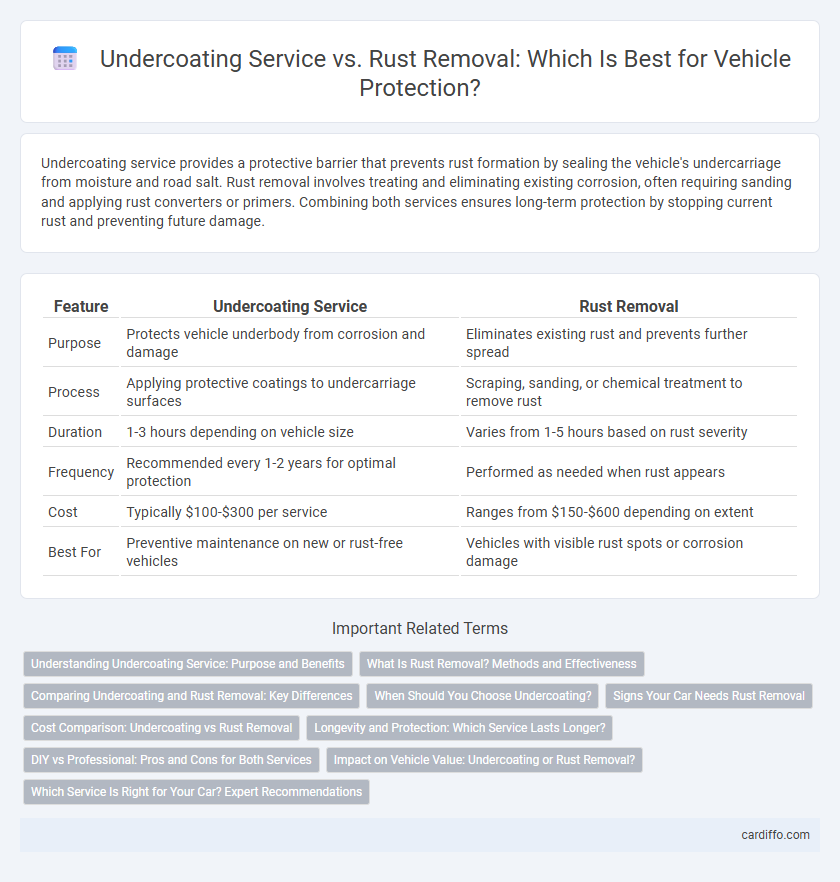Undercoating service provides a protective barrier that prevents rust formation by sealing the vehicle's undercarriage from moisture and road salt. Rust removal involves treating and eliminating existing corrosion, often requiring sanding and applying rust converters or primers. Combining both services ensures long-term protection by stopping current rust and preventing future damage.
Table of Comparison
| Feature | Undercoating Service | Rust Removal |
|---|---|---|
| Purpose | Protects vehicle underbody from corrosion and damage | Eliminates existing rust and prevents further spread |
| Process | Applying protective coatings to undercarriage surfaces | Scraping, sanding, or chemical treatment to remove rust |
| Duration | 1-3 hours depending on vehicle size | Varies from 1-5 hours based on rust severity |
| Frequency | Recommended every 1-2 years for optimal protection | Performed as needed when rust appears |
| Cost | Typically $100-$300 per service | Ranges from $150-$600 depending on extent |
| Best For | Preventive maintenance on new or rust-free vehicles | Vehicles with visible rust spots or corrosion damage |
Understanding Undercoating Service: Purpose and Benefits
Undercoating service involves applying a protective layer to the underbody of a vehicle to shield it from moisture, salt, and debris, thereby preventing rust formation. This treatment enhances vehicle durability, reduces corrosion-related repairs, and maintains resale value. Unlike rust removal, which addresses existing corrosion damage, undercoating serves as a proactive measure to protect metal surfaces and extend the vehicle's lifespan.
What Is Rust Removal? Methods and Effectiveness
Rust removal involves eliminating corrosion from metal surfaces to restore structural integrity and appearance. Common methods include mechanical abrasion, chemical rust converters, and electrolysis, each varying in effectiveness depending on rust severity and surface type. Proper rust removal enhances metal longevity, preventing further deterioration and improving the success of subsequent protective coatings.
Comparing Undercoating and Rust Removal: Key Differences
Undercoating service involves applying a protective layer to a vehicle's underside to prevent future rust and corrosion, enhancing long-term durability. Rust removal focuses on eliminating existing rust through sanding, grinding, or chemical treatments to restore the metal surface. While undercoating is preventive, rust removal addresses current damage, making both services complementary in maintaining vehicle integrity.
When Should You Choose Undercoating?
Choose undercoating service when you want to provide long-term protection against rust, especially in regions with heavy road salt use or frequent moisture exposure. Undercoating creates a durable barrier on your vehicle's underbody to prevent corrosion before rust develops, ideal for new or rust-free vehicles. Opt for rust removal only if visible corrosion has already formed, as undercoating is preventative and best applied proactively.
Signs Your Car Needs Rust Removal
Visible rust spots, bubbling paint, or flaking metal on your car's surface indicate the need for rust removal rather than just undercoating service. Undercoating primarily protects against future corrosion, but it cannot reverse existing rust damage that compromises the vehicle's structural integrity. Addressing rust removal promptly prevents further deterioration and costly repairs, ensuring your car's longevity and safety.
Cost Comparison: Undercoating vs Rust Removal
Undercoating service typically costs between $100 and $300, providing a protective barrier that prevents rust formation, while rust removal expenses can range from $200 to over $1,000 depending on the severity of corrosion and required repairs. Investing in undercoating is generally more cost-effective as it reduces the need for expensive rust removal treatments and extends vehicle longevity. Evaluating vehicle condition and budget helps determine whether preventive undercoating or reactive rust removal is the better financial choice.
Longevity and Protection: Which Service Lasts Longer?
Undercoating service provides a durable protective barrier against moisture, salt, and debris, significantly extending a vehicle's lifespan by preventing rust formation. Rust removal addresses existing corrosion but does not prevent future rust unless combined with protective measures like undercoating. Therefore, undercoating offers longer-lasting protection and enhances overall vehicle longevity compared to rust removal alone.
DIY vs Professional: Pros and Cons for Both Services
Undercoating service provides a protective barrier against moisture and salt, significantly preventing rust formation, while rust removal targets existing corrosion to stop further damage. DIY undercoating may save money but risks uneven application and reduced effectiveness, whereas professional services ensure thorough coverage with specialized equipment. Rust removal requires precision and safety measures, making professional intervention preferable to avoid damaging the vehicle frame or spreading rust improperly during DIY attempts.
Impact on Vehicle Value: Undercoating or Rust Removal?
Undercoating service enhances vehicle value by providing long-term protection against rust, sealing the undercarriage to prevent moisture and salt damage. Rust removal addresses existing corrosion, restoring the vehicle's appearance and preventing further deterioration, which can improve resale value if done thoroughly. Choosing between undercoating and rust removal depends on the vehicle's current condition; proactive undercoating is ideal for newer vehicles, while rust removal is essential for older models with visible corrosion to maximize value retention.
Which Service Is Right for Your Car? Expert Recommendations
Undercoating service provides a protective barrier that prevents moisture and salt from causing rust, making it ideal for vehicles exposed to harsh weather or road conditions. Rust removal is essential when corrosion has already set in, restoring the affected areas and preventing further damage. Experts recommend choosing undercoating for preventative care and opting for rust removal when visible corrosion compromises the vehicle's structural integrity.
Undercoating Service vs Rust Removal Infographic

 cardiffo.com
cardiffo.com